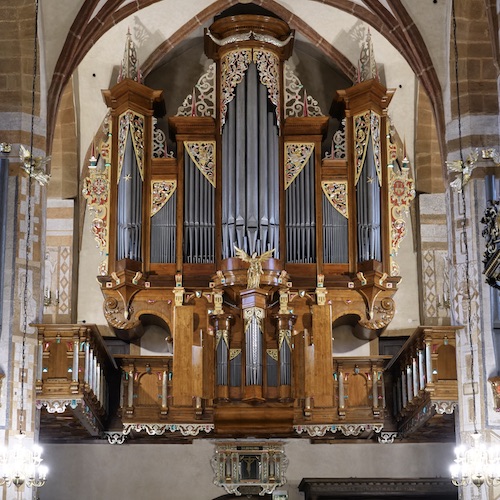HUMMEL/NITROWSKI
Basilica of St. Andrew the Apostle Olkusz
Organ details
History
1611-1623 phased construction of a new organ by Hans Hummel
ca. 1618 unsuccessful examination of the organ
1622 damage to the organ as the result of a lightning strike
1631 Georg Nitrowski senior completes the organ
1633 corrections to the reed stops carried out by Georg Nitrowski senior
1780 Christian Friedrich Scheffler of Brieg (Silesia) restores the organ
1839 restoration and changes by Jan Słotwiński from Kraków. Sałamaia 4’, Kromport 8’ and Cymbał (Positive) as well as Mixtura and Pomorth 16’ (pedal) removed, principal chorus completed using pipes from the redundant pedal mixture and the reduced mixture of the main manual.
1886 restoration and new bellows by Ludwig Niezabitowski of Pińczów
1945 restoration by Stanisław Krukowski of Piotrów Trybunalski
1972-1992 restoration by the State Historical Building Conservation Company of Kraków
2015-2018 restoration by Flentrop Orgelbouw of Zaandam (mechanism and pipes) and Marcin Chmielewski of Kraków (organ case)
The history of the main organ of the Minor Basilica of St Andrew the Apostle in Olkusz begins in 1611, when the Olkusz city authorities signed a contract with Hans Hummel, a Kraków organ builder originally from Nürnberg, for the building of the instrument. Archival materials made public in 2016 confirm that the instrument was built with six more stops than originally planned. The good reputation enjoyed by Hummel resulted, shortly thereafter, in two more orders of almost identical size: the rebuilding of the organ above the pulpit at St Mary’s Church in Kraków and a new instrument at St James’ Church in Levoča, Slovakia. The long distances between the towns in question (as well, perhaps, as the death of his four-year-old son) resulted in Hummel struggling to coordinate the activities of his workshop, which (as evidenced by inscriptions discovered in the Olkusz organ) employed an international group of workers. Hummel interrupted work on the various contracted organs several times, simultaneously changing his place of residence. Consequently, both St Mary’s in Kraków and the Olkusz parish decided to take legal action to resolve the unsatisfactory situation. After the personal intervention of the Polish king, Zygmunt III Vasa, Hummel – at the time resident in Levoča – was accused of misappropriating church property, and summoned to appear before the court in Kraków. Crushed by the burden of responsibility, Hummel died – probably from an act of suicide – in Levoča in 1630. Hummel’s employers in Levoča, Kraków and Olkusz thus found themselves in a comparable situation, obliged to find an organ builder who would undertake the completion of the various instruments. The organ builder in question was Georg Nitrowski senior, who later founded a renowned dynasty of at least three generations of organ builders responsible for instruments in a large portion of the First Republic’s territory during the 17 th and early 18th centuries. Nitrowski was educated by Hans Hummel, which could have been the reason he was deemed the most appropriate person for the organs in question. Nitrowski was charged with building or installing five unfinished stops, work on certain ‘unfinished portions of the organ’, and bringing the whole to a proper state of ‘harmony’. Nitrowski’s work in Olkusz was positively received in 1631. Some final corrections were made by Nitrowski senior in 1633. The Olkusz organ probably survived the second half of the 18th century without any major alterations, though it was repaired by, among others, Friedrich Wilhelm Scheffler of Brzeg. Only at the beginning of the 19th century did damage to the church, caused among other things by damp, make its mark on the organ’s condition. The first major work on the instrument was undertaken in 1839 by Jan Słotwiński of Kraków. He restored the organ, whilst removing some pipes from the mixture stops, using them to fill in gaps elsewhere. The end of the 19th century heralded the removal of eight of the instrument’s bellows. In the first few decades of the 20th century, only minor repairs to the organ were made, including those undertaken in 1945 by Stefan Krukowski of Piotrków Trybunalski. Thereafter, the organ’s condition gradually deteriorated. Thanks to the extensive endeavours of the church institutions, Olkusz City Council, the state conservation services and private individuals, a detailed restoration project was initiated, undertaken in various phases between 1972 and 1992. The project was carried out by the State Historical Building Conservation Company of Kraków, with input from a number of important Polish organ experts of the time. After 1992, however, ongoing Europe-wide research, both archival and organological, laid bare the need for significant further work. Of particular importance were the activities of the Baltisches Orgel Centrum e. V. in Stralsund (Germany), a distinguished association active in the restoration of Polish and German organs. A large body of information, unique in the history of Polish organology, was successfully gathered from Polish, Slovak, Ukrainian and German archives, as well as from the examination of numerous relevant instruments. Among other things special attention was paid to the reconstruction of the eight wedge bellows, the positive case doors, reed stops and the instrument’s proper tuning system as well as the restoration of the case’s original colour scheme and the adjacent musicians’ balconies. Above all, a detailed inventory of the pipework was undertaken, establishing original pipe lengths and the original location of each pipe within the organ. Thanks to the patronage of the Herman-Reemtsma-Stiftung in Hamburg, it became possible to commence the restoration in 2015, and to complete it some three years later. Shortly thereafter, numerous patrons became involved in the foundation’s activities, including the Ministry of Culture and National Heritage, the Ministry of Internal Affairs and Administration, the Provincial Historical Preservation Office in Kraków and private sponsors. From the beginning, the work was carried out under the close supervision of the Małopolskie Province Historical Building Conservator in Kraków, and an international group of experts consisting of Prof. Krzysztof Urbaniak (Łódź/Kraków – team leader), Prof. Marcin Szelest (Kraków), Prof. Pieter van Dijk (Amsterdam/Hamburg), Dr. Dorothea Schröder (Cuxhaven) and Martin Rost (Stralsund). In addition, archival research was carried out by Piotr Matoga (Kraków) and Bartosz Skop (Elbląg/Gdańsk). The organ’s pipework and mechanisms were restored by the renowned Flentrop Orgelbouw firm (Zaandam, the Netherlands) whilst the organ case and musicians’ balconies were restored by Marcin Chmielewski’s MODULUS atelier (Kraków).
Multimedia library
Specification
| Manuał C, D, E, F, G, A – g2, a2 | Pozytyw C, D, E, F, G, A – g2, a2 | Pedał C, D, E, F, G, A – d1, e1 |
| Principał 8 (+) Fleit wielki 8 (+) Salcinał 8 (+) Octawa 4 (+) Fleit octawnÿ 4 (+) Spilfleit octawnÿ 4 (+) Quinta 3 (+) Quindecima 2 (+) Gembshorn 2 (+) Mixtura VII (+) Cymbał V (+) Puzan 8 | Quintathena 8 (+) Principał 4 (+) Fleit octawnÿ 4 (+) Octawa 2 (+) Flecik mnieiszÿ 2 (+) Scadek 1 Mixtura III (+) Cymbał III (+) Kromport 8 Sałamaia 4 | Principał 16 (+) Octawa 8 (+) Fleit wielki 8 (+) Quinta 6 Quindecima 4 (+) Fleit octawnÿ 4 (+) Mixtura VI (+) Pomorth 16 Cornet 2 |
Tympan (drum stop) (+)
Gwiazdy (stars) (+)
Słowik (nightingale)
8 wedge bellows
quarter-comma meantone temperament
a1 = ca. 480 Hz
(+) original or partly original stops




